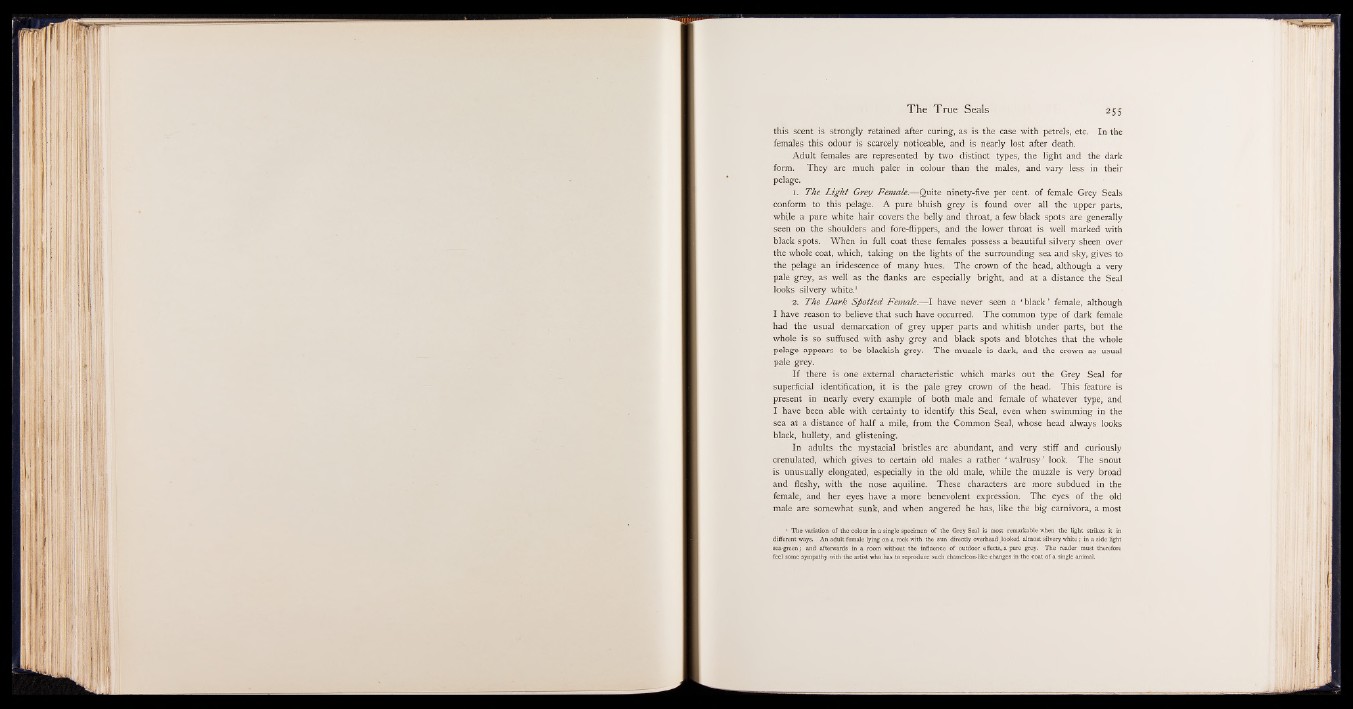
this scent is strongly retained after curing, as is the case with petrels, etc. In the
females this odour is scarcely noticeable, and is nearly lost after death.
Adult females are represented by two distinct types, the light and the dark
form. They are much paler in colour than the males, and vary less in their
pelage.
1. The Light Grey Female.— Quite ninety-five per cent, of female Grey Seals
conform to this pelage. A pure bluish grey is found over all the upper parts,
while a pure white hair covers the belly and throat, a few black spots are generally
seen on the shoulders and fore-flippers, and the lower throat is well marked with
black spots. When in full coat these females possess a beautiful silvery sheen over
the whole coat, which, taking on the lights of the surrounding sea and sky, gives to
the pelage an iridescence of many hues. The crown of the head, although a very
pale grey, as well as the flanks are especially bright, and at a distance the Seal
looks silvery white.1
2. The Dark Spotted Female.— I have never seen a ‘ black ’ female, although
I have reason to believe that such have occurred. The common type of dark female
had the usual demarcation of grey upper parts and whitish under parts, but the
whole is so suffused with ashy grey and black spots and blotches that the whole
pelage appears to be blackish grey. The muzzle is dark, and the crown as usual
pale grey.
I f there is one external characteristic which marks out the Grey Seal for
superficial identification, it is the pale grey crown of the head. This feature is
present in nearly every example of both male and female of whatever type, and
I have been able with certainty to identify this Seal, even when swimming in the
sea at a distance of half a mile, from the Common Seal, whose head always looks
black, bullety, and glistening.
In adults the mystacial bristles are abundant, and very stiff and curiously
crenulated, which gives to certain old males a rather ‘ walrusy’ look. The snout
is unusually elongated, especially in the old male, while the muzzle is very broad
and fleshy, with the nose aquiline. These characters are more subdued in the
female, and her eyes have a more benevolent expression. The eyes of the old
male are somewhat sunk, and when angered he has, like the big carnivora, a most
1 The variation of the colour in a single specimen of the Grey Seal is most remarkable when the light strikes it in
different ways. An adult female lying on a rock with the sun directly overhead .looked almost silvery white; in a side light
sea-green; and afterwards in a room without the influence of outdoor effects, a pure grey. The reader must therefore
feel some sympathy with the artist who has to reproduce such chameleon-like changes in the coat of a single animal.